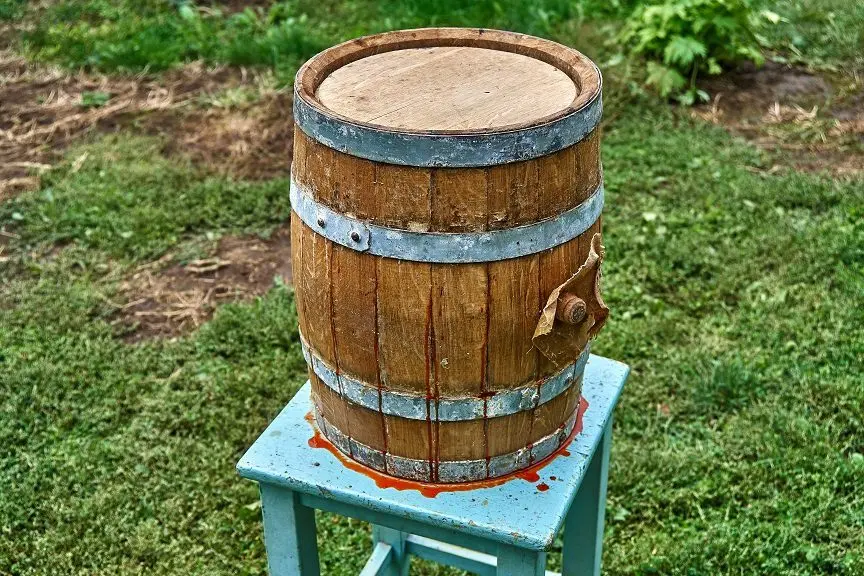Sooner or later, microcracks appear in any wooden barrel, then the elements diverge, forming cracks that leak. If you do not do repairs in time, there is a risk of irretrievably losing not only the drink inside, but also the product itself. Even a novice distiller can fix a leak in an oak barrel with his own hands. In most cases, water and a hammer are sufficient.
The main reasons for the appearance of a leak: improper or insufficient preparation of the barrel for the first use, drying out due to improper storage conditions, a hidden defect or deformation of the wood over time. Regardless of the cause, the elimination of the leak is carried out by the same methods.
After filling with distillate or wine for the first 2 weeks, it is advisable to inspect the barrel for leaks 1-2 times a day, then the frequency can be reduced to one per week. On examination, first of all, pay attention to the crane, bottoms and places near the hoops. Repairs are started only when a leak or a wet mark is detected, but if the wood is simply covered with small cracks or spots (except for mold), this is normal.
Methods to deal with a barrel leak
The described methods will work only if the leak is weak and the liquid does not flow out in a jet, otherwise it is better to hand over the barrel for repair to a qualified cooper.
1. Lifting hoops. Universal method for empty, dried and filled barrels. When the wood dries, tenths of a millimeter are enough for the hoop to jump off a little and a leak to appear in the barrel.
To solve the problem, you will need a heavy hammer (from 800 grams) and a hard object that can rest against the hoop, for example, a chisel. Having set the chisel at a right angle on the edge of the hoop, with the blows of a hammer on the chisel, the hoop is planted in a circle closer to the widest part of the barrel. First work with hoops near the center of the barrel, then with those near the edges. It is important not to overdo it, and not to hammer the hoops tightly.

As a result of the upsetting of the hoops, the oak barrel is compressed more strongly, the cracks become smaller and the flow between the staves disappears.
2. Water soak. The easiest way to deal with a leak. When moisture is absorbed, the wood expands, closing the gaps even without third-party intervention. Water is used to seal leaks from new barrels and those that have been kept dry after the wine or distillate has been aged in them.
The procedure for preparing a new oak barrel for use is described in a separate material, this is a mandatory procedure.
An empty dry barrel after aging the drink should be filled with boiling water to 80-90% of the volume, wait for it to cool to room temperature, then drain the water and fill the barrel with boiling water again. Repeat the procedure 3-4 times until the leak disappears. Water can be left in the barrel for a maximum of 2-3 days, then it is impossible, otherwise it will go bad. After each drain of the liquid, it is advisable to slightly tighten the hoops as in the first method.
3. Waxing. Wax is an environmentally friendly gap sealing material that, when used correctly, does not affect the taste and aroma of the drink inside the barrel. Often, waxing is used if the two previous methods have not worked.
Instructions: release the contents of the barrel, dry the wood at the leak site with a hair dryer, melt the wax in a water bath and evenly apply with a brush to the leak site, wait for the wax to dry completely, then refill the barrel with distillate or wine. If necessary, repeat the procedure several times.
4. Cooper’s mastics. Home distillers sell special mastics for cooperage, which often consist of a mixture of paraffin, wax and calcium carbonate. The advantage of mastics over wax is that they are easier to apply, it is possible to choose the color of the mastics that will not spoil the aesthetic appearance of the barrel, and the treatment can also be carried out without heating in any room.
Some home craftsmen, at their own peril and risk, eliminate barrel leaks with aquarium silicone, alabaster and other substances.
It should be borne in mind that the treatment of large cracks and gaps (especially through ones) with wax and other mastics is fraught with putty getting inside the barrel, as a result, the wood and the drink inside will deteriorate, so the use of mastics is risky and not always justified.









